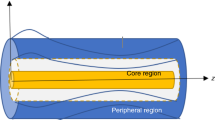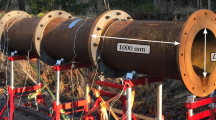Abstract
In this paper, the self-similar solutions for a strong cylindrical or spherical blast (shock) wave in real gas and inert solid particles mixture are analyzed on the basis of the perturbation method. The similarity solution in analytical forms is derived for first-order approximation, and a set of ODE for second-order approximations is also derived using the perturbation method proposed by Sakurai in perfect gas. The physical variable’s distribution in the entire flow field after the blast wave is shown in the figures. The effects of the ratio of the density of the solid inert particles to the initial gas density, mass concentration of particles, and the parameter of real gas effect on the physical variables, the peak pressure on blast wave and the damage radius of blast wave are investigated. It is found that the peak pressure on the blast wave and the damage radius of the blast wave both decrease with an increase in the value mass concentration of solid particles or non-idealness of the gas in the mixture. A comparison has also been made between the cylindrical and spherical geometries. It is found that the blast (shock) wave is more influential in the case of spherical geometry in contrast to that in the cylindrical geometry case. Also, the blast wave decay is due to an increase in the solid particle’s mass concentration or gas non-idealness parameter, and its strength increases with an increase in the ratio of the solid particles to the initial gas density.



Similar content being viewed by others
References
Ferrier KM (2001) The interstellar environment of our galaxy. Rev Mod Phys 73:1031–1066
Glovers SCO, Clark PC (2012) Is molecular gas necessary for star formation. Mon Not R Astron Soc 421:9–19
Lehmann A, Wardle M (2018) Two-fluid dusty shocks: simple benchmarking problems and applications to protoplanetary discs. Mon Not R Astron Soc 476:3185–3194
Pai S I (1977) Two Phase Flows. Chap.V, Vieweg Tracts in Pure Appl. Phys. Vol. 3, Vieweg Verlag, Braunschweig
Pai SI, Menon S, Fan ZQ (1980) Similarity solution of a strong shock wave propagation in a mixture of a gas and dust particles. Int J Eng Sci 18:1365–1373
Miura H, Glass II (1983) On the passage of a shock wave through a dusty gas layer. Proc Roy Soc London A385:85–105
Popel SI, Gisko AA (2006) Charged dust and shock phenomena in the solar system. Nonlinear Process Geophys 13:223–229
Gretler W, Regenfelder R (2005) Strong shock wave generated by a piston moving in a dust-laden gas under isothermal condition. Eur J Mech B/Fluids 24:205–218
Steiner H, Hirschler T (2002) A self-similar solution of a shock propagation in a dusty gas. Eur J Mech B/Fluids 21:371–380
Vishwakarma JP, Nath G (2006) Similarity solutions for unsteady flow behind an exponential shock in a dusty gas. Phys Scri 74:493–498
Popel SI, Tytovich VN, Yu MY (1998) Shock structures in plasmas containing variable charge macro particles. Astrophys Space Sci 250:107–123
Vishwakarma JP, Nath G (2009) A self-similar solution of a shock propagation in a mixture of a non-ideal gas and small solid particles. Meccanica 44:239–254
Nath G (2014) Self-similar solution for unsteady flow behind an exponential shock in an axisymmetric rotating dusty gas. Shock Waves 24:415–428
Nath G, Vishwakarma JP (2016) Propagation of a strong spherical shock wave in a gravitating or non-gravitating dusty gas with exponentially varying density. Acta Astronatica 123:200–213
Miura H, Glass II (1985) Development of the flow induced by a piston moving impulsively in a dusty gas. Proc Roy Soc London A 397:295–309
Sedov LI (1982) Similarity and dimensional methods in mechanics. Mir Publishers, Mascow
Korobeinikov VP (1976) Problems in the theory of point explosion in gases. Proceedings of the Steklov Institute of Mathematics, No.-119, American Mathematical Society
Ro S, Matzner CD (2017) Shock dynamics in stellar outbursts. I Shock Form Astrophys J 841:1–9
Dessart L, Livne E, Waldman R (2010) Shock-heating of stellar envelopes: a possible common mechanism at the origin of explosions and eruptions in massive stars. Mon Not Roy Astron Soc 405:2113–2131
Sedov LI (1946) Propagation of strong shock waves. J Appl Math Mech 10:241–250
Taylor GI (1950) The formation of a blast wave by a very intense explosion. I. Theoretical discussion. Proc Royal Soc Lond Series A 201:159–174
Taylor GI (1950) The formation of a blast wave by a very intense explosion.-II. The atomic explosion of 1945. Proc R Soc Lond A 201(1065):175–186
Woltjer L (1972) Supernova remnants. Ann Rev Astron Astrophys 10:29–158
Sakurai A (1982) Solution of point source blast wave equation. J Phys Soc Jpn 51:1355–1356
Sakurai A (1953) On the propagation and structure of the blast wave, I. J Phys Soc Jpn 8:662–669
Sakurai A (1954) On the propagation and structure of a blast wave, II. J Phys Soc Jpn 9:256–266
Allen GE, Chow K, DeLaney T, Filipovic MD, Houck JC, Pannuti TG, Stage MD (2015) On the expansion rate, age, and distance of the supernova remnant G266.2–1.2 (Vela Jr.). Astrophys J 798:82
Lerche I, Vasyliunas VM (1976) Mathematical theory of isothermal blast waves and the question of their applicability to supernova remnants. Astrophys J 210:85–99
Solinger A, Buff J, Rappaport S (1975) Isothermal blast wave model of supernova remnants. Astrophys J 201:381–386
Leahy DA, Ranasinghe S (2016) Distance and Evolutionary State of the Supernova Remnant 3C 397 (G41.1–0.3). Astrophys J 817:74
Anisimov SI, Spiner OM (1972) Motion of an almost ideal gas in the presence of a strong point explosion. J Appl Maths Mech 36:883–887
Ranga Rao MP, Purohit NK (1976) Self-similar piston problem in non-ideal gas. Int J Eng Sci 14:91–97
Wu CC, Roberts PH (1993) Shock wave propagation in a sonoluminescing gas bubble. Phys Rev Lett 70:3424–3427
Roberts PH, Wu CC (1996) Structure and stability of a spherical implosion. Phys Lett A 213:59–64
Vishwakarma JP, Nath G (2007) Similarity solutions for the flow behind an exponential shock in a non-ideal gas. Meccanica 42:331–339
Nath G, Vishwakarma JP (2014) Similarity solution for the flow behind the shock wave in a non-ideal gas with heat conduction and radiation heat flux in magnetogasdynamic. Commun Nonlinear Sci Numer Simulat 19:347–1365
Nath G (2019) Cylindrical shock wave generated by a moving piston in a rotational axisymmetric non-ideal gas with conductive and radiative heat-fluxes in the presence of azimuthal magnetic field. Acta Astronatica 156:100–112
Nath G (2015) Similarity solutions for unsteady flow behind an exponential shock in an axisymmetric rotating non-ideal gas. Meccanica 50:1701–1715
Nath G, Dutta M, Pathak RP (2020) Exact similarity solution for the propagation of spherical shock wave in a van der Waals gas with azimuthal magnetic field, radiation heat flux, radiation pressure and radiation energy under gravitational field. Proc Nat Acad Sci India 90A:789–801
Nath G, Kaur A, Chaurasia S (2021) On the blast wave propagation and structure in a rotational axisymmetric perfect gas. Proc Natl Acad Sci India Sec A Phys Sci. https://doi.org/10.1007/s40010-021-00737-w
Nath G (2021) Analytical solution for unsteady flow behind ionizing shock wave in a rotational axisymmetric non-ideal gas with azimuthal or axial magnetic field. Z Naturforsch 76a:265–283
Nath G (2021) Analytical solution for unsteady adiabatic and isothermal flows behind the shock wave in a rotational axisymmetric mixture of perfect gas and small solid particles. Z Naturforsch A 76:853–873
Nath G (2021) Approximate analytical solution for the propagation of shock wave in a mixture of small solid particles and non-ideal gas: isothermal flow. Zeitschrift für Naturforschung A. https://doi.org/10.1515/zna-2021-0196
Bethe HA, Fuchs K, Hirschfelder JO, Magee JL, Peierls RE, Von Neumann J (1958) Los Alamos Scientific Laboratory. Tech Rep, New Mexico
Author information
Authors and Affiliations
Corresponding author
Ethics declarations
Conflict of interest
The authors declare that they have no conflict of interest.
Additional information
Publisher's Note
Springer Nature remains neutral with regard to jurisdictional claims in published maps and institutional affiliations.
Significance Statement The shock wave problem study in real gas has established a great concentration of engineers and scientists due to its significant applications in science and engineering, such as in the study of the problem related to space sciences, chemical processes, and nuclear reactions, etc. The damage radius of the blast wave decreases, and the peak pressure remains unaltered with a change in geometry from spherical to cylindrical. The present study shows that the damage caused by the nuclear blast may be reduced by adding the dust particles.
Rights and permissions
Springer Nature or its licensor (e.g. a society or other partner) holds exclusive rights to this article under a publishing agreement with the author(s) or other rightsholder(s); author self-archiving of the accepted manuscript version of this article is solely governed by the terms of such publishing agreement and applicable law.
About this article
Cite this article
Nath, G. Analytical Solution for Unsteady Adiabatic Flow Behind the Blast Wave in a Non-ideal Gas and Small Inert Solid Particles Mixture. Proc. Natl. Acad. Sci., India, Sect. A Phys. Sci. 93, 279–292 (2023). https://doi.org/10.1007/s40010-023-00811-5
Received:
Revised:
Accepted:
Published:
Issue Date:
DOI: https://doi.org/10.1007/s40010-023-00811-5




